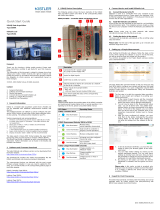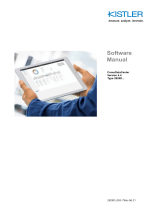Page is loading ...

First Step Guide
EN
jBEAM Lab/Durability/Powertrain
Starter/Professional/Ultimate
Type 2897A/2842A/2848A
2897A/2842A/2848A_012-052e-07.23_jBEAM_FirstStepGuide
Foreword
Thank you for choosing a Kistler quality product. Please read
these instructions carefully, so that you can take optimum
advantage of the versatile features of this product.
The information in this document is subject to change at any
time without prior notice. Kistler reserves the right to improve
and modify the product in accordance with technical progress
without the obligation to inform persons and organizations
based on these changes.
© 2023 Kistler Group. All rights reserved. Kistler Group pro-
ducts are protected by various intellectual property rights. For
more details visit www.kistler.com.
Contents
1. Import/Export of measurement data
2. Visualization of data
3. Analysis of data (Statistics and FFT)
1. Import/Export of measurement data
The following instructions describe the import/export of
measurement data in MDF and CSV format into/from jBEAM
Lab/Durability/Powertrain (Starter/Professional/Ultimate).
Import of MDF data
1. Select menu File → Import Values → MDF (ASAM v3/v4).
2. Select the MDF file to be imported in tab File Chooser.
3. Select the load status for each channel included in the
MDF file in tab Channel Selection:
The load status can be changed by clicking on the icons:
Channel shows up in jBEAM project and values are
imported
Channel shows up in jBEAM project but values
aren’t imported (will be imported automatically
when channel is used within project)
Channel does not show up in jBEAM project and
values aren’t imported
4. Import the data by clicking the Open button.
Import of CSV data
1. Select menu File → Import Values → ASCII.
2. Select the CSV file to be imported in tab File Chooser.
3. Select tab File Structure to define the structure of your
CSV file to be imported.
a. Meta data: Select the checkbox Load meta data and
define the first and last line of the meta data section if
meta data shall be imported.
b. Data start: Define the start line of the data section.
c. Separation character: Define the channel separation
character.
4. Select tab Meta Data and define the separation character
for the meta data:
5. Select tab Channel Header to define name and units of
channels. The header information can be entered for all chan-
nels or channel by channel and manually or from the file by
selecting the appropriate line.
a. Name: Define the channel name either by entering a name
manually or selecting the appropriate line in the file.
b. Unit: Define the unit either by entering a unit manually
or selecting the appropriate line in the file.
c. Time information: If the file does include an explicit
time channel this step (5c) can be skipped to proceed
with step 6. If not, define:
•x0: Start time (e.g. 0.0)
•Δx: Time increment per sample (e.g. 1.0E-4)
•x-Unit: Unit of time (e.g. s)
6. Select tab Data Formats to define the decimal separator
and time channel:
a. Decimal separator: Define the decimal separator
b. Time channel: Define the explicit time channel if the
file does include one by selecting checkbox Manual
X-channel and the appropriate channel (if not see step 5c)
7. Import the data by clicking the Open button.
Export in CSV format
1. Select menu File → Export Values → ASCII
2. Select tab Channel data:
a. Channel selection: Select the channels to be exported.
By default, the checkbox export all data is selected. If
you like to export specific channels only unselect the
checkbox export all data and select the channels to be
exported in the list Available Channels. By pressing the
button “>” you can add the selected channels to your
Selected Channels list. Only channels in the Selected
Channels list will be exported.
b. Separation character: Select the separation character for
the CSV export format.
c. Export channel properties: By default, channel
properties (name, unit, etc.) are exported. If the infor-
mation is not needed in the data export unselect the
checkbox Export channel properties.
d. Export values: By default, channel values of select-
ed channels are exported. If channel values are not
needed for instance if only channel properties are to
be exported unselect the checkbox Export values.
3. Select tab File Chooser and define the directory and file
name for the data export
4. Export the data by clicking the Export button
2. Visualization of data
The following instructions describe the visualization of mea-
surement data and analysis results and the zooming within
graphs.
Visualization of data in y/t graphs
Data and analysis results can be visualized in the working sheet
section (D) by simply drag & drop the data from the explorer
(C) to the working sheet. Multiple selection is possible by press-
ing Ctrl key while selecting the desired data in the explorer.
Common and multiple y-axis
If multiple signals are visualized in the same graph the y-axis
is common by default.
If multiple y-axis (one per signal) are preferred the graph
settings need to be configured as follows:
Right click on graph → Modify… → Button Stacked A
The y-axis can be reset to a common axis by selecting
Stacked B.
Zooming within graphs
• Window zoom: «Ctrl + Alt + Left Mouse Button»
• Axis zoom: «Ctrl + Left Mouse Button» on axis
• Moving signal within graph: «Ctrl + Left Mouse Button»
Cursors
Cursors can be added to a graph by Right click on graph →
Modify… Cursor.
The Analysis and Delta Cursorset are available and can be
selected by clicking on the corresponding button:
• Analysis cursorset:
The analysis cursor set consist of one y/t cursor pair
which indicates the y and t values of one single point of
a measurement curve.
• Delta cursorset:
The delta cursor set consists of two y/t cursor pairs
indicating the y and t values of one single point of a
measurement curve each. In addition y and t delta values
are indicated.
3. Analysis of data (Statistics and FFT)
The following instructions describe the analysis of mea-
surement data, specifically statistics and FFT. This is not
an exhaustive description of the analysis functions of
jBEAM, but is intended to show the concept of how
analyses are performed in jBEAM.
Statistics
Following example describes the calculation of min. and max.
value of an acceleration signal.
1. Select menu Math → Statistic → Extract Statistical Values
2. Window for statistical values calculation shows up
a. Enter a name for the statistics calculation:
b. Select the data importer and channel for the statistic
calculation (in this example the acceleration signal):
c. Select statistical quantity
to be calculated
(example: the minimum):
d. Use the proposed name for
the result or enter a name
(unselect checkbox to do so):
→Repeat steps b to d to add calculations for other
statistic values (maximum value in this example)
e. Confirm the calculation by clicking the OK button
3. The calculated statistic values are listed in the Explorer
window under the given names:
4. By selecting the statistical values in the Explorer window
and drag & drop them onto the Working sheet the results
can be visualized
FFT
Following example describes the calculation of a FFT of an
acceleration signal.
1. Select menu Math → Vibration Analysis (FFT) → FFT-
Spectrum
2. Window for FFT calculation shows up
a. Enter a name for the FFT calculation:
b. Select your calculation - amplitude and/or phase spec-
trum:
c. Select the data importer and channel for the FFT
calculation (in this example the acceleration signal):
d. Select the windowing function to be used for the FFT
calculation:
e. Confirm the calculation by clicking the OK button
3. The calculated FFT is listed in the Explorer window under
the given name:
4. By selecting the FFT results in the Explorer window and
drag & drop them onto the Working sheet the results can
be visualized.
Kistler Group
Eulachstrasse 22
8408 Winterthur, Switzerland
Tel. +41 52 224 11 11
info@kistler.com
www.kistler.com
/









